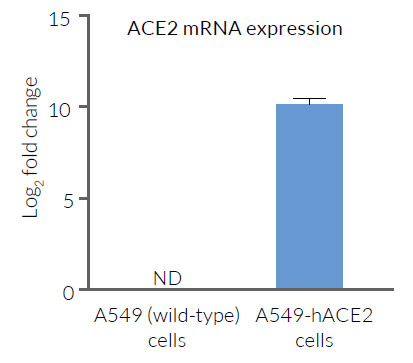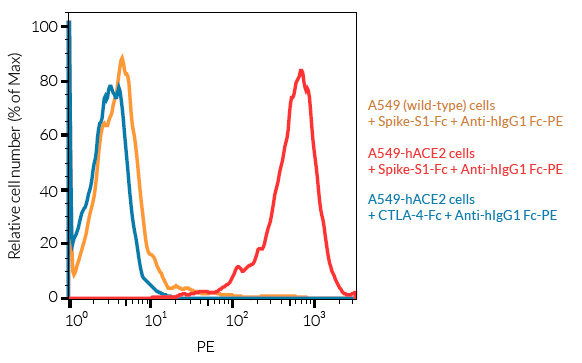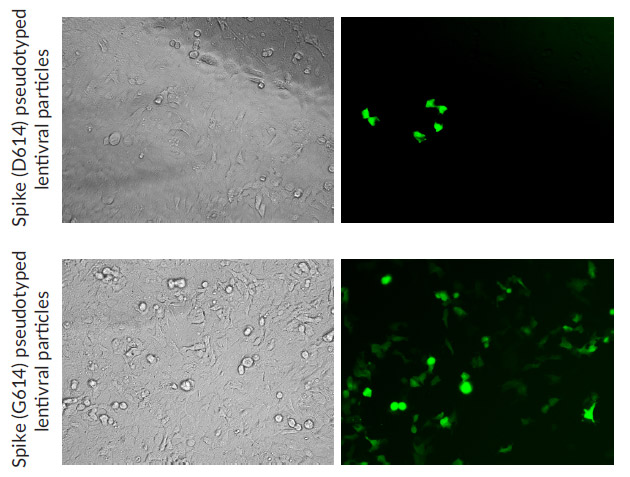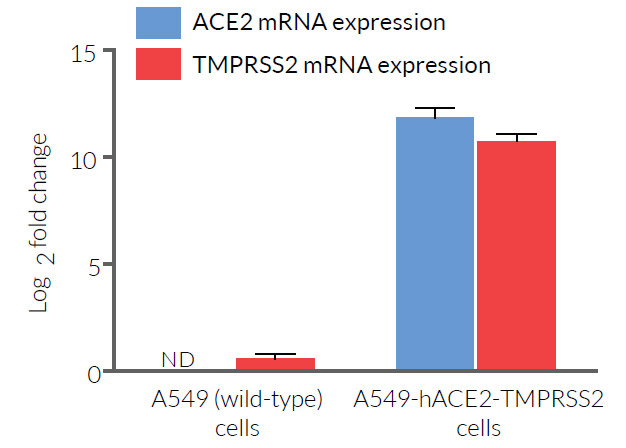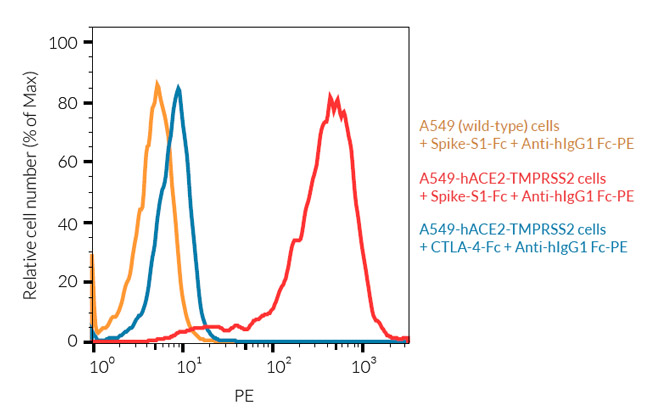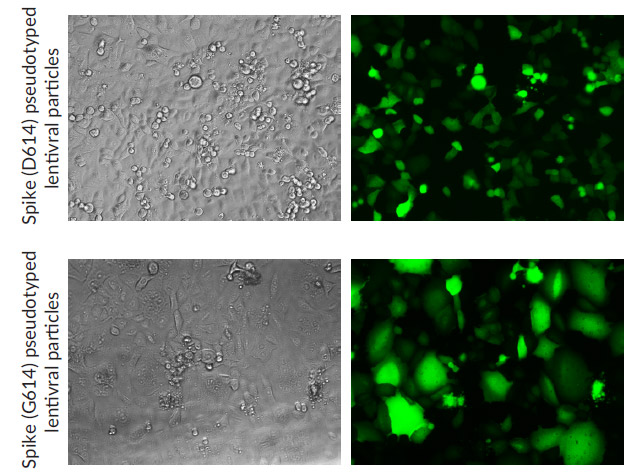Human ACE2 & TMPRSS2 expressing A549 Cells
| Product | Unit size | Cat. code | Docs. | Qty. | Price | |
|---|---|---|---|---|---|---|
|
A549-hACE2 Cells A549 lung carcinoma cells expressing human ACE2 |
Show product |
3-7 x 10e6 cells |
a549-hace2
|
|
||
|
A549-hACE2 vial Additional cell vial |
Show product |
3-7 x 10e6 cells |
a549-hace2-av
|
|||
|
A549-hACE2-TMPRSS2 Cells A549 lung carcinoma cells expressing human ACE2 and human TMPRSS2 |
Show product |
3-7 x 10e6 cells |
a549-hace2tpsa
|
|
||
|
A549-hACE2-TMPRSS2 vial Additional cell vial |
Show product |
3-7 x 10e6 cells |
a549-hace2tpsa-av
|
Notification: Reference #a549-hace2-av can only be ordered together with reference #a549-hace2.
Reference #a549-hace2tpsa-av can only be ordered together with reference #a549-hace2tpsa.
A549 lung carcinoma cells expressing the SARS-CoV-2 receptors ACE2 and TMPRSS2
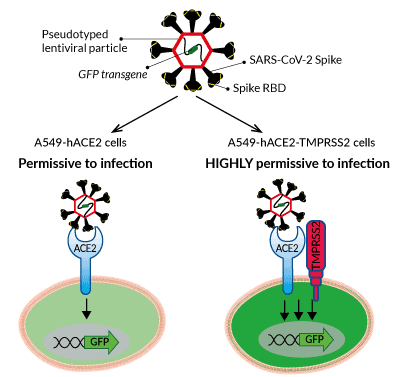
Permissivity of A549-hACE2 and A549-hACE2-TMPRSS2 cells to SARS-CoV-2 infection
InvivoGen offers human A549 lung carcinoma cell lines, specifically designed for COVID-19 studies:
— A549-hACE2 cells
— A549-hACE2-TMPRSS2 cells
These cells stably overexpress the genes encoding for the SARS-CoV-2 receptors, human ACE2, and TMPRSS2.
The A549 cell line is commonly used for the study of respiratory infections. SARS-CoV-2, the causative agent of coronavirus disease-19 (COVID-19), gains entry into the human lung epithelium through the interaction of the virus Spike protein with the host ACE2 and TMPRSS2 receptors [1, 2]. A549 cells express negligible levels of ACE2 and no TMPRSS2 and thus are poorly permissive to infection by SARS-CoV-2 or Spike pseudotyped lentiviral particles [1-3, in-house data]. To increase their permissivity, A549 cells have been stably transfected with the human ACE2 only, or ACE2 and TMPRSS2 genes. In contrast to A549 cells, A549-hACE2 cells are permissive to Spike pseudotyped lentiviral particles as visualized by the expression of the lentiviral GFP transgene. The addition of TMPRSS2 expression significantly increases the cell line infectivity (see Figures).
Key features:
- Overexpression of human ACE2 only, or ACE2 and TMPRSS2
-
Permissive to SARS-CoV-2 Spike pseudotyped lentiviral particles
Applications:
- Screening of small molecule inhibitors and/or neutralizing antibodies of the ACE2‑Spike interaction
- Screening of small molecule inhibitors and/or neutralizing antibodies of the TMPRSS2 surface protease
- Comparative studies of the effects of drugs targeting ACE2 and/or TMPRSS2 on the SARS-CoV-2 infection and cellular signaling outcomes
![]() Learn more about SARS-CoV-2 infection cycle, immune responses, and potential therapeutics.
Learn more about SARS-CoV-2 infection cycle, immune responses, and potential therapeutics.
References
1. Chen H. et al., 2020. SARS-CoV-2 activated lung epithelia cell proinflammatory signaling and leads to immune dysregulation in COVID-19 patients by single-cell sequencing. medRxiv: DOI 10.1101/2020.05.08.20096024.
2. Hoffmann M. et al., 2020. SARS-CoV-2 cell entry depends on ACE2 and TMPRSS2 and is blocked by a clinically proven protease inhibitor. Cell. 181:1-16.
3. Matsuyama S. et al., 2020. Enhanced isolation of SARS-CoV-2 by TMPRSS2-expressing cells. PNAS. 117(13):7001-7003.
Specifications
Growth medium: DMEM, 4.5 g/L glucose, 2 mM L-glutamine, 10% (v/v) heat-inactivated fetal bovine serum (FBS), 100 U/ml penicillin, 100 µg/ml streptomycin, 100 µg/ml Normocin™
Antibiotic resistance:
- A549-hACE2 cells: Puromycin
-
A549-hACE2-TMPRSS2 cells: Puromycin and Hygromycin
Quality Control:
- ACE2 gene expression has been verified by RT-qPCR, FACS staining, and functional assays.
- TMPRSS2 gene expression has been verified by RT-qPCR, and functional assays.
- The stability for 20 passages, following thawing, has been verified for A549-hACE2 and A549-hACE2-TMPRSS2 cells.
- These cells are guaranteed mycoplasma-free.
Contents
Please note: Each cell line is sold separately. See TDS for the exact contents of each cell line.
A549-hACE2 cells
- 3-7 x 106 A549-hACE2 cells in a cryovial or shipping flask
- 1 ml of Puromycin (10 mg/ml)
- 1 ml of Normocin™ (50 mg/ml). Normocin™ is a formulation of three antibiotics active against mycoplasmas, bacteria, and fungi.
A549-hACE2-TMPRSS2 cells
- 3-7 x 106 A549-hACE2-TMPRSS2 cells in a cryovial or shipping flask
- 1 ml of Puromycin (10 mg/ml)
- 1 ml of Hygromycin (100 mg/ml)
-
1 ml of Normocin™ (50 mg/ml). Normocin™ is a formulation of three antibiotics active against mycoplasmas, bacteria, and fungi.
![]() Shipped on dry ice (Europe, USA, Canada and some areas in Asia)
Shipped on dry ice (Europe, USA, Canada and some areas in Asia)
Details
ACE2 and TMPRSS2 Background:
ACE2 (angiotensin I-converting enzyme-2) and TMPRSS2 (transmembrane protease serine 2)play a critical role in the pathogenesis of COVID-19 by allowing viral entry into target cells (e.g. human lung epithelium). ACE2 and TMPRSS2 are cell-surface proteins that both interact with the virus Spike (S) protein [1-3]. ACE2 is mandatory for the binding of SARS-CoV-2 at the cell surface through its interaction with the Spike receptor-binding domain (RBD) [4]. Following this, TMPRSS2 cleaves the S protein into two functional subunits (S1 and S2), allowing virus-host membrane fusion, and the release of viral contents (e.g. RNA) into the cytosol [3-5]. Another protease, the Cathepsin L, also mediates cleavage of the S protein but it acts in the endosomes. Camostat is a clinically-proven inhibitor of TMPRSS2 and has been shown to inhibit SARS-CoV-2-S pseudotyped viral particles entry into primary human lung cells in a dose-dependent manner [2]. This observation demonstrates the critical implication of TMPRSS2 in SARS-CoV-2 infection and spread. Moreover, in lung cells that fail to express robust levels of Cathepsin L, the virus entry depends on a furin-mediated pre-cleavage of the S protein at the S1/S2 site, before subsequent TMPRSS2-mediated cleavage at the S2' site [6].
1. Chen H. et al., 2020. SARS-CoV-2 activated lung epithelia cell proinflammatory signaling and leads to immune dysregulation in COVID-19 patients by single-cell sequencing. medRxiv: DOI 10.1101/2020.05.08.20096024.
2. Hoffmann M. et al., 2020. SARS-CoV-2 cell entry depends on ACE2 and TMPRSS2 and is blocked by a clinically proven protease inhibitor. Cell. 181:1-16.
3. Matsuyama S. et al., 2020. Enhanced isolation of SARS-CoV-2 by TMPRSS2-expressing cells. PNAS. 117(13):7001-7003.
4. Zhou P. et al., 2020. A pneumonia outbreak associated with a new coronavirus of probable bat origin. Nature. 579(7798):270-273.
5. Walls A.C. et al., 2020. Structure, function, and antigenicity of the SARS-CoV-2 spike glycoprotein. Cell. 181(2):281-292.e6.
6. Hoffman M. et al., 2020. A multibasic cleavage site in the Spike protein of SARS-CoV-2 is essential for infection of human lung cells. Molecular Cell. 78:;1-6.






